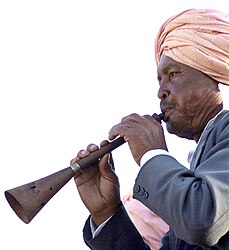 | |
| Wind Instrument | |
|---|---|
| Inventor(s) | Hynniew Trep People |
The tangmuri, ka tangmuri in the Khasi language, is a double-reed conical-bore wind-instrument used by the Hynniew Trep people of Meghalaya State in North-East India.[1]
The tangmuri is used by musicians playing for traditional dances, and for other traditional rituals, such as cremations performed according to the indigenous religion, Niam Khasi. The tangmuri delivers a very high pitched sound when played by the musician.
Description[edit]
The instrument consists of a turned conical-bore wooden chanter, about 20 cm long, with seven finger-holes on the front, and a separate flared turned 15 cm long wooden bell which is attached to the chanter by a push-fit.
The double-reed is tied onto a thin conical-bore metal tube around 3 cm long, which is wound with thread to hold it in place in the chanter.
Gallery[edit]
-
Tangmuri
-
Tangmuri showing its component parts
References[edit]
- ^ The Cultural Heritage of Meghalaya. United Kingdom, Manohar, 2020.


Well, that’s interesting to know that Psilotum nudum are known as whisk ferns. Psilotum nudum is the commoner species of the two. While the P. flaccidum is a rare species and is found in the tropical islands. Both the species are usually epiphytic in habit and grow upon tree ferns. These species may also be terrestrial and grow in humus or in the crevices of the rocks.
View the detailed Guide of Psilotum nudum: Detailed Study Of Psilotum Nudum (Whisk Fern), Classification, Anatomy, Reproduction